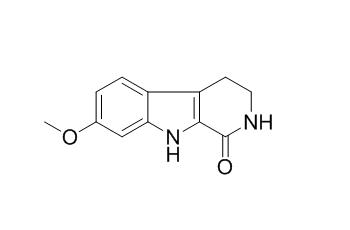Harmalacidine
Harmalacidine exhibits cytotoxicity against U-937 cells with IC50 value of 3.1 ± 0.2 μmol/L, the mechanism is targeting the mitochondrial and protein tyrosine kinase signaling pathways (PTKs-Ras/Raf/ERK).
Inquire / Order:
manager@chemfaces.com
Technical Inquiries:
service@chemfaces.com
Tel:
+86-27-84237783
Fax:
+86-27-84254680
Address:
1 Building, No. 83, CheCheng Rd., Wuhan Economic and Technological Development Zone, Wuhan, Hubei 430056, PRC
Providing storage is as stated on the product vial and the vial is kept tightly sealed, the product can be stored for up to
24 months(2-8C).
Wherever possible, you should prepare and use solutions on the same day. However, if you need to make up stock solutions in advance, we recommend that you store the solution as aliquots in tightly sealed vials at -20C. Generally, these will be useable for up to two weeks. Before use, and prior to opening the vial we recommend that you allow your product to equilibrate to room temperature for at least 1 hour.
Need more advice on solubility, usage and handling? Please email to: service@chemfaces.com
The packaging of the product may have turned upside down during transportation, resulting in the natural compounds adhering to the neck or cap of the vial. take the vial out of its packaging and gently shake to let the compounds fall to the bottom of the vial. for liquid products, centrifuge at 200-500 RPM to gather the liquid at the bottom of the vial. try to avoid loss or contamination during handling.
Biomolecules.2024, 14(5):589.
Plant Science2024, 338:111914
J Chromatogr B Analyt Technol Biomed Life Sci.2019, 1126-1127:121743
Molecules.2023, 28(13):4971.
Phytomedicine.2023, 117:154929.
J Appl Biol Chem.2024, 67:39,281-288.
Int J Anal Chem.2017, 2017:1254721
Front Plant Sci.2024, 15:1458916.
Processes2020, 8(12),1540.
Phytother Res.2019, 33(3):676-689
Related and Featured Products
Toxins (Basel). 2015 Nov 3;7(11):4507-18.
Cytotoxic indole alkaloids against human leukemia cell lines from the toxic plant Peganum harmala.[Pubmed:
26540074 ]
Bioactivity-guided fractionation was used to determine the cytotoxic alkaloids from the toxic plant Peganum harmala.
METHODS AND RESULTS:
Two novel indole alkaloids, together with ten known ones, were isolated and identified. The novel alkaloids were elucidated to be 2-(indol-3-yl)ethyl-α-L-rhamnopyranosyl-(1 → 6)-β-D-glucopyranoside (2) and 3-hydroxy-3-(N-acetyl-2-aminoethyl)-6-methoxyindol-2-one (3). The cytotoxicity against human leukemia cells was assayed for the alkaloids and some of them showed potent activity. Harmalacidine (compound 8, HMC) exhibited the highest cytotoxicity against U-937 cells with IC50 value of 3.1 ± 0.2 μmol/L. The cytotoxic mechanism of HMC was targeting the mitochondrial and protein tyrosine kinase signaling pathways (PTKs-Ras/Raf/ERK).
CONCLUSIONS:
The results strongly demonstrated that the alkaloids from Peganum harmala could be a promising candidate for the therapy of leukemia.
Pak J Pharm Sci. 2013 Jul;26(4):699-706.
Cytotoxicity of alkaloids isolated from Peganum harmala seeds.[Pubmed:
23811445]
Peganum harmala is used in traditional medicine to treat a number of diseases including cancer. Our preliminary studies show that the alkaloidal extract of PH seed is cytotoxic to several tumor cell lines in vitro and has antitumor effect in a tumor model in vivo.
The present investigation was aimed at extending our previous studies in identifying the components in P. harmala seed-extract responsible for the cytotoxic effects, and study the cytotoxic and antiproliferative activity of isolated alkaloids and total alkaloidal fraction (TAF) in several tumor cell lines.
METHODS AND RESULTS:
Four alkaloids: harmalicidine, harmine, peganine (vasicine) and vasicinone were isolated from the P. harmala seed-extract and their activity and that of TAF were tested a) for their cytotoxic activity against four tumor cell lines [three developed by us by chemical-induction in Wistar rats: 1) Med-mek carcinoma ; 2) UCP-med carcinoma ; 3) UCP-med sarcoma] ; and 4) SP2/O-Ag14, and b) for antiproliferative effect on cells of Jurkat, E6-1 clone (inhibition of incorporation of {(3)H-thymidine} in cellular DNA). The alkaloids and TAF inhibited the growth of tumor cell lines to varying degrees; Sp2/O-Ag14 was the most sensitive, with IC50 values (concentration of the active substance that inhibited the growth of the tumor cells by 50%) ranging between 2.43 μg/mL and 19.20 μg/mL, while UCP-med carcinoma was the least sensitive (range of IC50 = 13.83 μg/mL to 59.97 μg/mL). Of the substances evaluated, harmine was the most active compound (IC50 for the 4 tumor cell lines varying between 2.43 μg/mL and 18.39 μg/mL), followed by TAF (range of IC50 = 7.32 μg/mL to 13.83 μg/mL); peganine was the least active (IC50 = 50 μg/mL to > 100 μg/mL). In terms of antiproliferative effect, vasicinone and TAF were more potent than other substances: the concentration of vasicinone, and TAF needed to inhibit the incorporation of {(3)H-TDR} in the DNA cells of Jurkat, E6-1 clone by 50% (IC50) were 8.60 ± 0.023 μg/mL and 8.94 ± 0.017 μg/mL, respectively, while peganine was the least active (IC50 >100 μg/mL). The IC50 values for Harmalacidine (27.10 ± 0.011 μg/mL) and harmine (46.57 ± 0.011 μg/mL) were intermediate.
CONCLUSIONS:
The harmala alkaloids inhibited the growth of four tumor cell lines, and proliferation of Jurkat cells with varying potencies.
Harmine was the most potent in inhibiting cell growth, and vasicinone was most active as antiproliferating substance. The TAF had significant cytotoxic as well as antiproliferating activity.



